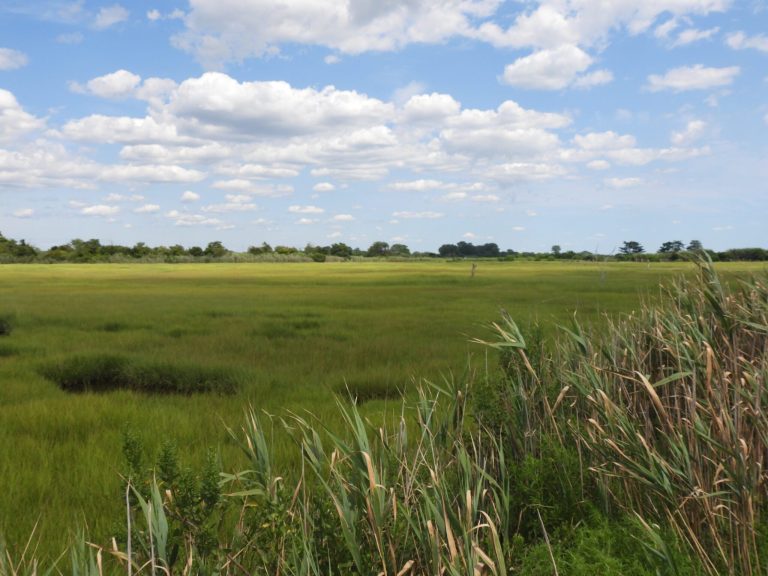
By Jennifer Wilson-Pines
There are lots of negative associations with wetlands from our vocabulary (swamped, bogged down) to the image of muddy, mosquito-ridden, out-of- the-way places mainly good for discrete dumping of bodies.
There are many descriptives for this type of environment: swamp, marsh, fen, bog, slough, mire, swale. Wetlands became the preferred term in 1953 when first used in a U.S. Fish and Wildlife Service report.
Though wetlands only account for 6% of land surface in the nation, they are super productive, containing 40% of the world’s biodiversity. Wetlands are diverse and can be found on the margins of freshwater lakes, ponds, rivers and streams.
Brackish wetlands are at the point where freshwater meets salt, like where streams run into bays and harbors along our shoreline and the mangrove wetlands of the South. Saltwater wetlands directly face the ocean and absorb the brunt of tidal action.
Each kind of wetland hosts plants and animals specially evolved for that habitat and climate.
In the United State, 95% of wetlands are freshwater, unless you live along the seaside or on an island, where those numbers can be reversed locally.
Wetlands are also one of the most threatened habitats, as humans have been filling them for hundreds of years. The USFWS recently released its sixth report on the status of wetlands in the U.S. (2009-2019) and it makes depressing reading. Wetland loss increased by more than 50% since the previous study with more than 221,000 acres lost, mostly by being filled.
Another type of loss of wetland is the change from vegetated to mudflats or being drowned into ponds or lakes.
According to the USFWS, wetlands provide these environmental benefits;
- Improve water quality – Often described as the “kidneys” of watersheds, wetlands are able to filter and trap pollutants, excess nutrients and sediment.
- Protect against flooding and stabilize shorelines – Wetlands act as a buffer that absorbs the energy and excess water from waves and storms, reducing flood damage to inland areas. Their vegetation and root systems also help prevent erosion.
- Recharge groundwater supply – If a wetland is connected to a groundwater system, it can help provide water when stream flows or lake levels are low. This helps maintain the water supply for drinking water and irrigation as well as for wildlife and plants.
- Sequester carbon – Wetlands capture carbon dioxide from the atmosphere and store it in soil and plants, helping to mitigate the impacts of climate change. Peatlands, for example, cover only about 3 percent of the Earth’s surface but store approximately twice the amount of carbon than the entirety of the world’s forests.
- Recreation opportunities – Healthy wetlands provide myriad opportunities to connect with nature, whether through photography, fishing, wildlife watching, boating, hunting, or hiking.
Though over half of wetlands in the U.S. have been lost in the last 200 years, things did begin to turn early in the last century. Protection of wetlands began in 1934 when Congress passed the Migratory Bird Hunting Stamp Act, which started the purchase and preservation of wetlands. In 1986, the Emergency Wetland Resources Act was adopted. Portions of the Clean Water Act and the Rivers and Harbors Act also protect wetlands.
In New York, the Tidal Wetlands Act was adopted by the state in 1973. In 2017, the DEC published Tidal Wetlands Guidance Document for Living Shoreline Techniques to “encourage appropriate use of living shorelines in place of hardened approaches for erosion control, because living shorelines offer greater habitat and ecological value than hardened shorelines and revetments.”
In 1975 the New York State Legislature passed the Freshwater Wetlands Act, which covers most of the wetlands in the state. Its purpose is “declared to be the public policy of the state to preserve, protect and conserve freshwater wetlands, and the benefits derived therefrom, to prevent the despoliation and destruction of freshwater wetlands, and to regulate use and development of such wetlands to secure the natural benefits of freshwater wetland, consistent with the general welfare and beneficial economic, social, and agricultural development of the state.” In 2023 that protection was expanded to cover an additional million acres of smaller wetlands.
Despite their importance to diversity and protective functions, wetlands are still overlooked. On Long Island we are lucky to have many types of wetlands protecting our shorelines and waters. They are extra important here because of their ability to filter water both recharging our sole source aquifer and removing contaminants before they flow into the bays and Long Island Sound. They also serve as natural buffers to the tidal storm surges as well as important habitats to a huge variety of plants and animals. Wetlands are something to celebrate and protect even if you don’t want to go tromping in the mud.







